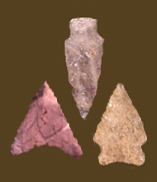
|
HARDAWAY SIDE NOTCHED Defining Attributes Chronology The Hardaway Side Notched, Hardaway Blade, and Hardaway-Dalton points appear to be related Paleoindian period types. All three were recovered from the same occupation zone at the Hardaway site in North Carolina. Coe (1964) assumed these three types occurred as variations over a fairly long period prior to the beginning of the Early Archaic, and that the Hardaway Side Notched was a specialized form, the last of the three to be developed. Other scholars see the varieties as more contemporary, and place the Hardaway/Hardaway-Dalton complex at 10,500 to 9900 BP (approximately 10,550-9350 BC in calendar years), based on radiocarbon dates from the Midwest (Goodyear 1982). Although no radiocarbon dates have been obtained for the Hardaway Side Notched in the mid-Atlantic, McAvoy and McAvoy (1997) suggest a temporal placement of 10,200 to 10,000 BP (10,000-9550 BC), based on its stratigraphic position at the Slade site in Virginia. Description Blade: The blade is broad and very thin, in general forming the shape of an equilateral triangle below the notch. The sides are usually straight, but occasionally rounded. Haft Element: Concave and ground, the base is often so deep that it is notch-like. Side notches are narrow, deep, and U-shaped, averaging 4 mm deep and 5 mm wide. Broad, shallow flakes, frequently extending a third of the distance down the face, thin most bases. Size: Length ranges from 28 to 50 mm, with an average of 35 mm. Width ranges from 23 to 35 mm, with an average of 25 mm. Thickness ranges 3 to 6 mm, with an average of 4 mm. Hardaway Side Notched points are generally smaller than Hardaway-Dalton examples (Daniel 1998). Technique of manufacture: Although similar to the soft percussion flaking used on the Hardaway-Dalton, all edges were carefully pressure flaked on the Hardaway Side Notched, producing a more delicate point. The primary flakes were typically broad and shallow, while the secondary flakes were long and narrow. Material: Most Hardaway varieties found in Maryland are made of jasper or chert, but quartz, quartzite, and rhyolite have been reported (Brown 1979; Steponaitis 1980; Wanser 1982). Discussion According to Coe (1964), the Hardaway Blade, Hardaway-Dalton, and Hardaway Side Notched points appear to be related types that follow one another in time. However, others have argued that the variations reflect contemporary stages of tool use and re-sharpening, or geographical differences (Ward and Davis 1999). Defined in Literature References |
![]()
Search by Shape:
(See Projectile Point Typology) |

|
Thank you for visiting our website. If you have any
questions, comments, Copyright © 2002 by |

|

